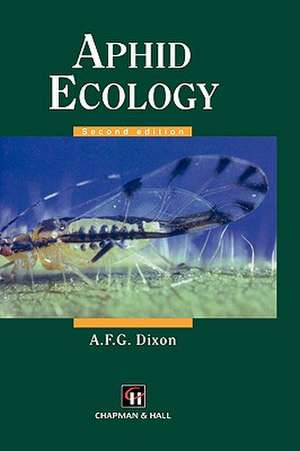Aphid Ecology An optimization approach
Autor A.F.G. Dixonen Limba Engleză Hardback – 30 noi 1997
Increasing knowledge of aphids has revealed that they are ideal organisms to use when studying many topical ecological issues. They are particularly important for testing predictions of life history theory, as their clonal structure makes it possible to test the response of a genotype to a wide range of conditions.
Aphid Ecology has been thoroughly revised and expanded since the first highly successful edition was published in 1985. This book is aimed at specialists, post graduates and advanced undergraduates working in the fields of ecology and entomology.
| Toate formatele și edițiile | Preț | Express |
|---|---|---|
| Paperback (1) | 1381.12 lei 6-8 săpt. | |
| SPRINGER NETHERLANDS – 6 noi 2012 | 1381.12 lei 6-8 săpt. | |
| Hardback (1) | 1223.74 lei 6-8 săpt. | |
| SPRINGER NETHERLANDS – 30 noi 1997 | 1223.74 lei 6-8 săpt. |
Preț: 1223.74 lei
Preț vechi: 1492.37 lei
-18% Nou
Puncte Express: 1836
Preț estimativ în valută:
234.16€ • 243.90$ • 195.20£
234.16€ • 243.90$ • 195.20£
Carte tipărită la comandă
Livrare economică 29 martie-12 aprilie
Preluare comenzi: 021 569.72.76
Specificații
ISBN-13: 9780412741807
ISBN-10: 0412741806
Pagini: 300
Ilustrații: IX, 300 p.
Dimensiuni: 155 x 235 x 19 mm
Greutate: 0.62 kg
Ediția:2nd ed. 1985
Editura: SPRINGER NETHERLANDS
Colecția Springer
Locul publicării:Dordrecht, Netherlands
ISBN-10: 0412741806
Pagini: 300
Ilustrații: IX, 300 p.
Dimensiuni: 155 x 235 x 19 mm
Greutate: 0.62 kg
Ediția:2nd ed. 1985
Editura: SPRINGER NETHERLANDS
Colecția Springer
Locul publicării:Dordrecht, Netherlands
Public țintă
ResearchCuprins
1 Introduction.- 1.1 Distinguishing features of aphids.- 1.2 Origin of aphids.- 1.3 Host plant associations.- 1.4 Classification.- 1.5 Distribution.- 2 Feeding behaviour and food quality.- 2.1 Feeding behaviour.- 2.2 Food quality.- 2.3 Nitrogen metabolism.- 2.4 Symbionts.- 3 Host specificity and speciation.- 3.1 Proximate factors in host selection.- 3.2 Food quality.- 3.3 Evolution of host specificity.- 3.4 Speciation.- 4 Size.- 4.1 Size within a species.- 4.2 Optimum body size.- 4.3 Species size diversity.- 4.4 Geometrical similarity.- 4.5 Size of migrants.- 4.6 Reproduction.- 5 Resource tracking: mechanism — cyclical parthenogenesis.- 5.1 Telescoping of generations.- 5.2 Intra-clonal variation.- 5.3 Adaptability of aphid clones.- 5.4 Genetic structure.- 5.5 Sex.- 5.6 Why reproduce sexually?.- 5.7 Timing of sex.- 5.8 Sex ratios.- 5.9 Mate guarding.- 5.10 Why lay eggs?.- 6 Resource tracking: mechanism — polyphenism.- 6.1 Defence.- 6.2 Dispersal.- 6.3 Reproduction.- 6.4 Parthenogenetic reproduction.- 6.5 Sexual reproduction.- 6.6 Aestivation and hibernation.- 6.7 Ecological patterns.- 7 Resource tracking in time.- 7.1 Host alternation.- 7.2 The historical debate.- 7.3 Experimental evidence.- 7.4 Autoecious way of life.- 7.5 Generation-specific strategies.- 7.6 Habitat predictability and tactical diversity.- 7.7 Response to habitat quality.- 8 Resource tracking in space.- 8.1 Mechanisms.- 8.2 Timing.- 8.3 Distance travelled.- 8.4 Adaptive significance.- 9 Population dynamics.- 9.1 Dynamics of aerial populations.- 9.2 Intensive studies.- 9.3 Patterns.- 9.4 Processes.- 9.5 Natural enemies.- 9.6 Intraspecific differences in abundance.- 9.7 Interspecific differences in abundance.- 9.8 Abundance and global warming.- 9.9 Forecasting of pest aphid outbreaks.- 9.10 Spatialdynamics.- 10 Community structure and species diversity.- 10.1 Mutualism between plants and aphids.- 10.2 Aphids and plant growth.- 10.3 Aphids and the seeding of plants.- 10.4 Ants and plant fitness.- 10.5 Mutualism between aphids and ants.- 10.6 Endophyte-enhanced plant resistance to aphids.- 10.7 Energy and nutrient flow.- 10.8 Competition.- 10.9 Species diversity and plant architectural complexity.- 10.10 Size diversity.- 10.11 Distribution, abundance and variability.- 10.12 Rarity.- 10.13 Why are there so few species of aphids, especially in the tropics?.- 11 Epilogue.- References.

























